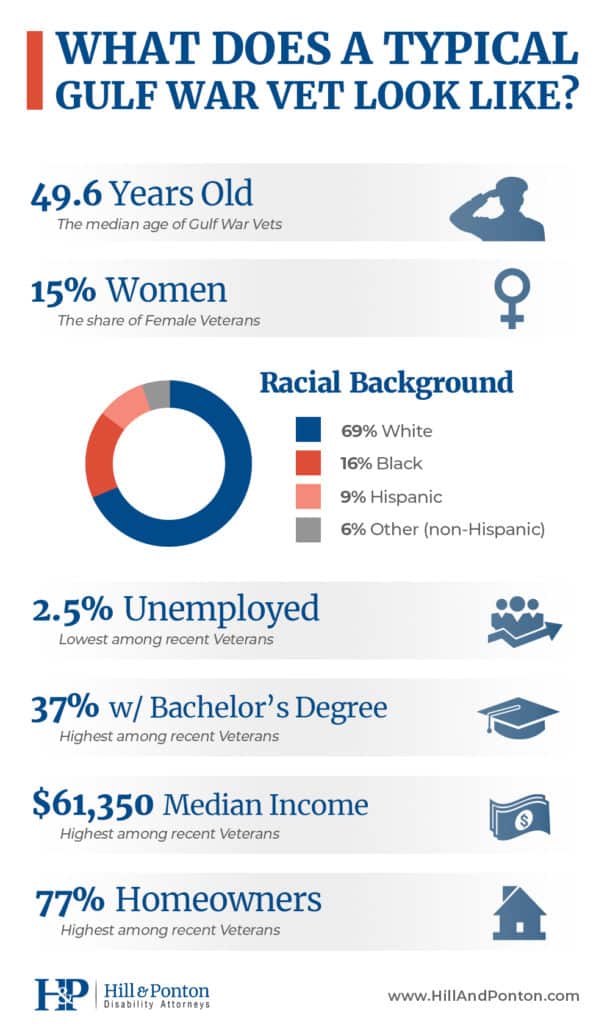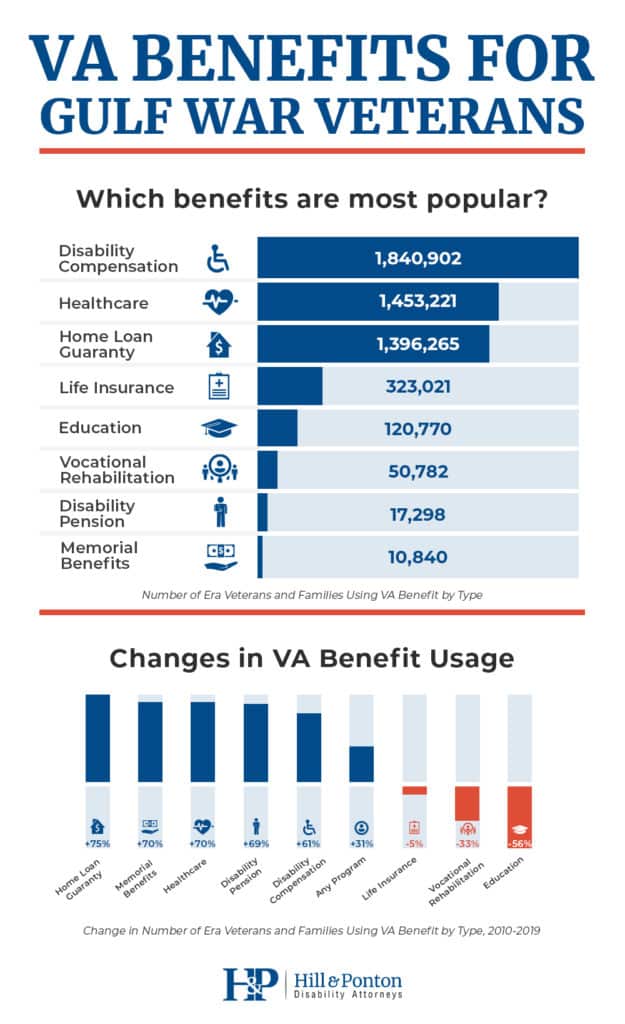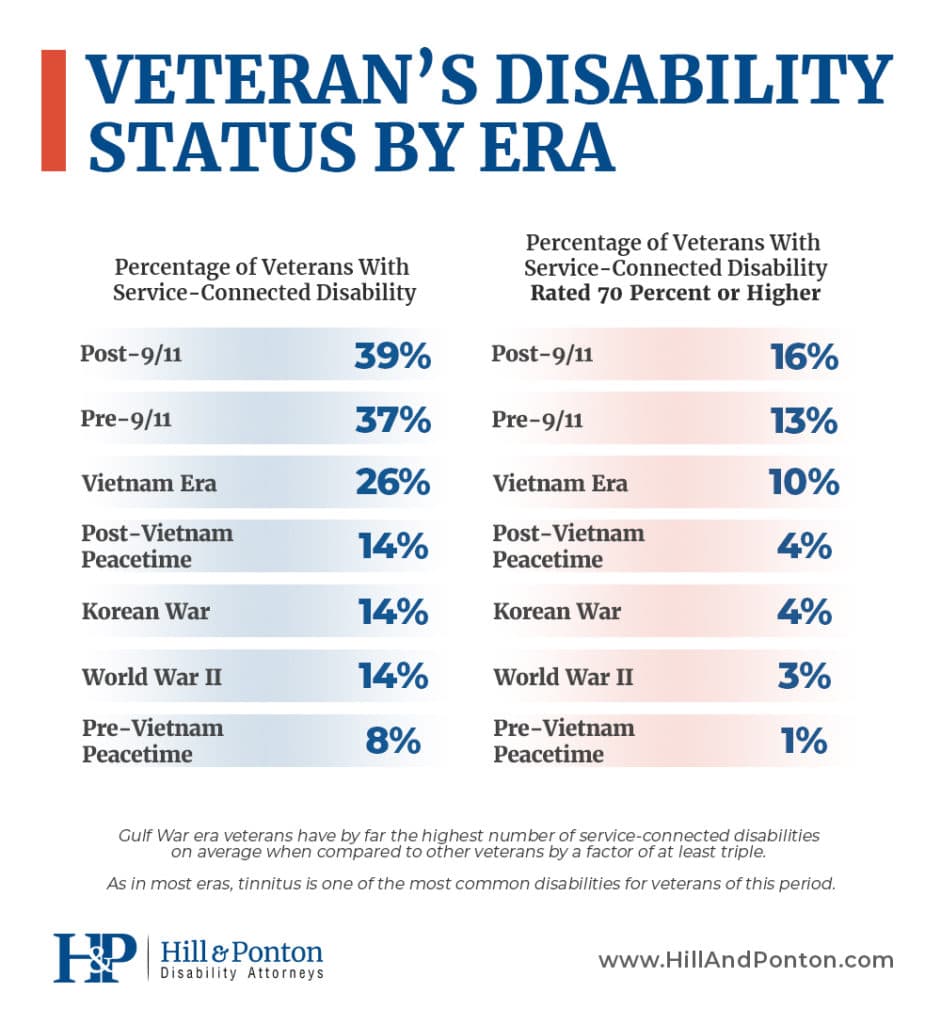
About 650,000 people served in Operation Desert Shield/Operation Desert Storm. The conflict began Aug. 2, 1990, with combat formally ending Feb. 28, 1991. While fewer than 400 American service members were killed during the war, those who served continue to experience physical and emotional implications.
We analyzed data from the Department of Veterans Affairs and U.S. Census Bureau to learn more about Gulf War veterans, especially the health effects they face and the benefit programs that are the most popular with them.
Who Are Gulf War Veterans?
Formally, the Gulf War period is still going on, and anybody who served in active duty since Aug. 2, 1990 is considered a Gulf War veteran, regardless of whether they were involved in Operation Desert Shield or Operation Desert Storm. Some federal reports split the era into two sections: pre-9/11 and post-9/11.
The average veteran of the initial Gulf War period is nearing 50 years of age. They’re more likely than post-9/11 veterans to own their own homes, and their median annual income is just over $61,000.
What Does a Typical Gulf War Veteran Look Like?

Select Statistics on First Gulf War Era Veterans
Age & Gender
- 49.6 years median age
- 15% share of female veterans
Racial Background
- White: 69%
- Black: 16%
- Hispanic: 9%
- Other (non-Hispanic): 6%
Economic & Educational Status
- 2.5% unemployed, lowest among recent veterans
- 37% have bachelor’s degree, highest among recent veterans
- $61,350 median annual income, highest among recent veterans
- 77% homeowners, highest among recent veterans
About 22 percent of all living American military veterans served in the first Gulf War era, but their numbers are greater in some states than in others. According to Census Bureau figures, Virginia (35 percent) has the highest percentage of Gulf War veterans, followed by Alaska (34 percent) and Maryland (28 percent). Only 15 percent of veterans in New Jersey served in the first Gulf War era, which is the lowest rate of any state.
States With Biggest Gulf War Area Veteran Populations
States by Percentage of Veteran Population Who Served During First Gulf War Era

| State | Percentage of Veterans |
|---|---|
| Virginia | 35% |
| Alaska | 34% |
| Colorado | 28% |
| Georgia | 28% |
| Maryland | 28% |
| Texas | 27% |
| Alabama | 26% |
| South Carolina | 26% |
| North Carolina | 25% |
| Louisiana | 24% |
| Nevada | 24% |
| Oklahoma | 24% |
| Tennessee | 24% |
| Utah | 24% |
| Washington | 24% |
| Hawaii | 23% |
| Kentucky | 23% |
| Mississippi | 23% |
| Wyoming | 23% |
| Arizona | 22% |
| Delaware | 22% |
| Florida | 22% |
| Nebraska | 22% |
| Arkansas | 21% |
| District of Columbia | 21% |
| Idaho | 21% |
| Montana | 21% |
| New Mexico | 21% |
| North Dakota | 21% |
| South Dakota | 21% |
| Kansas | 20% |
| Maine | 20% |
| Missouri | 20% |
| West Virginia | 20% |
| California | 19% |
| Illinois | 19% |
| Indiana | 19% |
| Iowa | 19% |
| New Hampshire | 19% |
| Ohio | 19% |
| Michigan | 18% |
| Oregon | 18% |
| Pennsylvania | 17% |
| Vermont | 17% |
| Wisconsin | 17% |
| Connecticut | 16% |
| Massachusetts | 16% |
| Minnesota | 16% |
| New York | 16% |
| New Jersey | 15% |
| Rhode Island | 15% |
What Benefits Are Most Popular for Gulf War Veterans?
Recent veterans are far more likely than those who served in previous areas to have a service-connected disability. On average about 38 percent of pre- and post-9/11 Gulf War veterans have a disability that resulted from their service in the armed forces.
About 60 percent of all pre-9/11 Gulf War veterans use some type of VA benefit, with disability and healthcare benefits being the most popular, according to data from the Department of Veterans Affairs. Additionally, the rate at which this group uses any VA benefit has climbed by about 50 percent over the past decade.
Gulf War Veterans & VA Benefits: Past and Present

Number of Era Veterans and Families Using VA Benefit by Type
| Veteran Benefit | Number of Veterans Using |
|---|---|
| Disability compensation | 1,840,902 |
| Healthcare | 1,453,221 |
| Home loan guaranty | 1,396,265 |
| Life insurance | 323,021 |
| Education | 120,770 |
| Vocational rehabilitation | 50,782 |
| Disability pension | 17,298 |
| Memorial benefits | 10,840 |
| Veteran Benefit | Change in Benefit Usage |
|---|---|
| Home loan guaranty | 75% |
| Memorial benefits | 70% |
| Healthcare | 70% |
| Disability pension | 69% |
| Disability compensation | 61% |
| Any program | 31% |
| Life insurance | -5% |
| Vocational rehabilitation | -33% |
| Education | -56% |
What Health Problems Do Gulf War Veterans Deal With?
While the conflict itself killed fewer than 200 U.S. service members, Gulf War veterans are still experiencing long-term health effects. In addition to Gulf War Syndrome, which the VA doesn’t formally recognize, first Gulf War-era veterans are more likely to suffer from certain service-connected disabilities.
In part because the average Gulf War vet has more disabilities than others, the rates at which they suffer each one is more spread out. For example, while tinnitus is first at about 7 percent for Gulf War veterans, it accounts for 11 percent for Vietnam vets and 21 percent for veterans of the Korean conflict.
Gulf War era veterans also have the second-highest average annual disability compensation figure, second only to Vietnam era veterans.
Number and Type of Disabilities & Annual Compensation

Average Number of Service-Connected Disabilities per Veteran by Era of Service
| Era | # of Service-Connected Disabilities |
|---|---|
| Gulf War | 7.2 |
| Vietnam Era | 2.4 |
| Peacetime | 2.3 |
| Korean War | 1.9 |
| World War II | 1.8 |
| Service-Connected Disability | Percentage of Gulf War Veterans Claiming |
|---|---|
| Tinnitus | 6.5% |
| Limitation of knee flexion | 5.6% |
| Lumbosacral or cervical strain | 4.9% |
| Scars | 3.6% |
| Post-traumatic stress disorder | 3.5% |
| Ankle motion limitation | 3.3% |
| Migraine | 3.0% |
| Arm motion limitation | 2.7% |
| Sciatic nerve paralysis | 2.6% |
| Degenerative spinal arthritis | 2.4% |
| Era | Average Annual Compensation |
|---|---|
| Vietnam Era | $19,238 |
| Gulf War Era | $17,730 |
| World War II | $13,772 |
| Korean War | $12,641 |
| Peacetime | $12,507 |
Recent veterans, including those serving both before and after 9/11, are more likely than their older counterparts to have service-connected disabilities, according to the VA. Not only are they more likely to have suffered a disability during their service, but their disabilities also tend to be more severe as well.
Veterans’ Disability Status by Era of Service

Percentage of Veterans With Service-Connected Disability
| Era | % of Veterans with Service-Connected Disability |
|---|---|
| Post-9/11 | 39% |
| Pre-9/11 | 37% |
| Vietnam Era | 26% |
| Post-Vietnam peacetime | 14% |
| Korean War | 14% |
| World War II | 14% |
| Pre-Vietnam peacetime | 8% |
| Era | % of Veterans Rated 70%+ |
|---|---|
| Post-9/11 | 16% |
| Pre-9/11 | 13% |
| Vietnam Era | 10% |
| Post-Vietnam peacetime | 4% |
| World War II | 4% |
| Korean War | 3% |
| Pre-Vietnam peacetime | 1% |
Gulf War era veterans have by far the highest number of service-connected disabilities on average when compared to other veterans by a factor of at least triple. As in most eras, tinnitus is one of the most common disabilities for veterans of this period.
Caring for Gulf War Veterans
They have the second-highest annual compensation rate of the estimated 18 million American veterans, and no other era’s veterans have more service-connected disabilities than those who served between Aug. 2, 1990 and Sept. 11, 2001.
Ensuring Gulf War veterans receive all the benefits they’re entitled to can mean the difference between getting treatment for their physical and emotional effects — or not. Hill & Ponton has spent the past three decades managing more than 30,000 veteran claims and Social Security disability cases. We’ve recovered more than $300 million for our clients, and we help veterans navigate life with disabilities. Get a free case evaluation today at HillandPonton.com.
Methodology
Our analysis of Gulf War veterans was informed by data from the U.S. Department of Veterans Affairs and the U.S. Census Bureau. In every case, there are direct links included to each table or dataset in question so you can explore more on your own.
About 650,000 people served in Operation Desert Shield/Operation Desert Storm. The conflict began Aug. 2, 1990, with combat formally ending Feb. 28, 1991. While fewer than 400 American service members were killed during the war, those who served continue to experience physical and emotional implications.
We analyzed data from the Department of Veterans Affairs and U.S. Census Bureau to learn more about Gulf War veterans, especially the health effects they face and the benefit programs that are the most popular with them.




